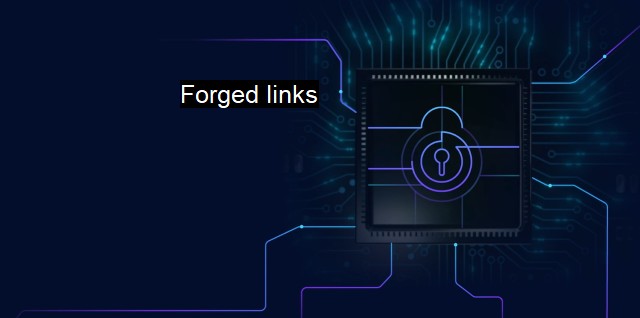What are Forged links?
Understanding Forged Links: The Threat of Cybercriminals in Cybersecurity and Antivirus
With the proliferation of technology, the rise of cybersecurity threats has been inevitable. One notable threat that individuals and businesses alike face is the concept of 'forged links', a prevalent mechanism in the realm of cybersecurity and antivirus. Forged links can be a detrimental contributing factor to cyberterrorism and identity theft, thereby emphasizing the need for robust protective systems today.Forged links are disguised hyperlinks that direct users to sites with malicious intent. Developed commonly by hackers and cybercriminals, these are genuinely represented in emails or websites and have increasingly become prevalent across numerous digital platforms. Forged links bear the familiar appearance, often imitating trusted organizations', and are contained in emails, making users unaware of any deceit amidst them.
These links often warp distorted websites that are replicas of those that users are used to interacting with regularly. This familiar design psychologically instills a level of trust among users, leading them to input sensitive data such as login credentials, personal identity data or even bank details.
The primary characteristics of forged links consist of discrepant URLs, which are usually concealed with the aid of techniques such as long hyperlinks and URL shorteners and the accurate imitation of organizations' interfaces. Fundamentally, the abnormalities underline how skilled cybercriminals have honed their programming to enhance the authenticity of falsified links.
Understanding the implications of forged links rests greatly in fully grasping how they jeopardize the cybersecurity space and beyond. Cybercriminals with deceitful intent exploit forged links in nefarious cyber-attacks, from 'spear phishing' attacks, which make use of personalized crafted emails directed towards an individual or organization, to pharming attacks, which involves redirecting users to fraudulent websites without their consent.
The effects of forged links penetrates not only personal cybersecurity but corporate security systems as well. This infiltration exposes significant points of vulnerability and encourages one to reflect on the augmentation of developmental antivirus mechanisms used in risk mitigation strategies within the technological world.
These strategies look towards antivirus software, which shields computers and by extension, networks, from malicious external forces attempting to gain undesignified access. Biometric authentications, more prominent in personal cybersecurity, are also being integrated into remote systems, mainly providing an extra layer against identity theft.
Another significant strategy in dealing with forged links includes education around cyber threat identification for employees and consumers alike. Knowledge and awareness of the presence of this cybersecurity danger promote individual autonomy in data security, allowing people to make more informed and safer choices in their digital interactions.
An advance in technology is the 'link protection’ that antivirus programs now often provide. This feature represents a layer of real-time control on hyperlinks while also giving warnings of potential forgeries. Files that are non-compliant with security protocols and regulations are also flagged, adding further depth to the line of defense.
Besides, cybersecurity companies are actively pushing encrypted connections to reduce the risk of forged links having unintended consequences on their customers. Implementing secure protocol layers such as HTTPS is proven beneficial in battling these potentially harmful misrepresentations.
The incorporation of forged links in cyber-attacks detriments personal cybersecurity and the overall cybersecurity realm, underscoring the compelling need for comprehensive antivirus mechanisms. From a preventative standpoint, crafted strategies focusing on awareness, software, and encryption reduce the odds of digitized stakeholders falling prey to counterfeit influences. As technology and its resulting threats continue to evolve, maintaining constant vigilance and investing in comprehensive protective measures remains the overarching imperative.

Forged links FAQs
What are forged links in cybersecurity?
Forged links are malicious URLs created by cybercriminals to trick users into clicking on them. They often appear as legitimate links but lead to fake websites or malware-infected pages.How do forged links work?
Forged links work by exploiting the trust users have in familiar sites or brands. They use social engineering tactics such as phishing emails, text messages, or social media posts to lure users into clicking on them. Once clicked, the link can install malware, steal personal information, or direct the user to a fake login page.What are the dangers of clicking on forged links?
Clicking on forged links can lead to various cyber threats, such as malware infections, phishing scams, and identity theft. Malware can compromise your system and steal sensitive information, while phishing scams can trick you into giving up your login credentials or personal information. Identity theft can occur when sensitive information is stolen and used for fraudulent purposes.How can I protect myself from forged links?
To protect yourself from forged links, you should always verify the sender and the link's destination before clicking on them. Avoid clicking on suspicious links and use security software, such as antivirus and firewalls. Keep your software up to date and use strong passwords. Additionally, user education and awareness training can help you recognize and avoid phishing scams and other cyber threats.| | A | | | B | | | C | | | D | | | E | | | F | | | G | | | H | | | I | | | J | | | K | | | L | | | M | |
| | N | | | O | | | P | | | Q | | | R | | | S | | | T | | | U | | | V | | | W | | | X | | | Y | | | Z | |
| | 1 | | | 2 | | | 3 | | | 4 | | | 7 | | | 8 | | |||||||